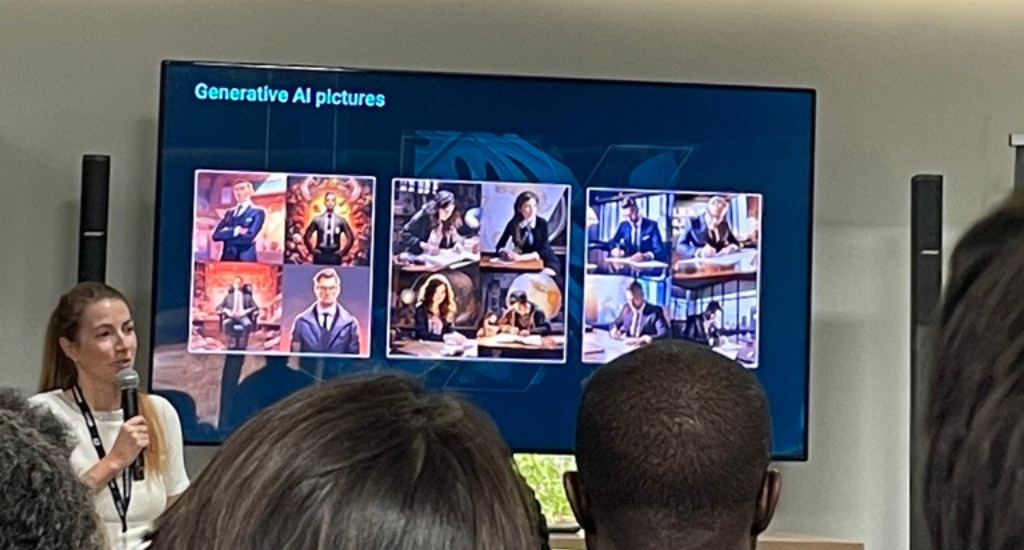This article retraces the conference by Marie Kuter, UX consultant, organized on September 19, 2023 in Paris during the first edition of UX-Conf – Human First. This conference addresses the theme of the persona, and in particular the objective of establishing new ones based on three criteria:
- accessibility
- The diversity
- Inclusion
What is a persona?
Marie Kuter begins by defining what a persona is: “It is a key deliverable to synthesize the information collected following user research“. It is therefore a key reference to rely on, where the visual of the personas is defined according to user feedback.
The birth of a project
“Diverse personas” in English, is a project launched by the UX consultant in May 2023, which focuses on deepening the analysis of personas. To do this, several sources were used:
Nowadays, 211 people were analyzed. The objective is to observe whether they reflect an accessible and inclusive world. In order to establish an observation on existing personas, the analysis is structured around 4 axes:
- The genus
- Skin color
- The age
- The disability.
Attributes of power include title, facial expression, chosen environment, hair and clothing.
Persona analysis
Marie Kuter reveals the first results of her analysis: iThere seems to be about the same number of women and men. On the other hand, combining the factors of gender and skin color represents only 1/5 of projects. LThese personas are generally portrayed as being between 20 and 65 years old. Also, among these 211 profiles, only one is represented with a disability (with a cane for walking).
The first analysis already allows us to draw up a first observation: in terms of representation, the diversity made up of people from different backgrounds relating to gender and skin color seems to match, Conversely disability and age. In addition, the “diversity”, “inclusion” and “accessibility” factors are not combined to establish a persona. We then find ourselves with excluded people such as the elderly, those with disabilities or young people.
On the sample made up of 211 personas, Marie Kuter explains that we are still far from reality. Indeed, dOn the one hand, women are represented as having:
- long, loose hair
- “casual” and colorful clothes
- manager or student titles.
On the other hand, men are represented as having:
- short, black hair
- suit/tie type clothing
- expert or entrepreneur titles.
This information makes it possible to observe and establish a trend: eIn terms of posture and context, there is a certain balance between men and women. However, inequality are observed in particular at the level of the title, the expression, the style or even the accessories. Thus, theThese personas convey a feeling of stereotype, very limited and targeted with very unequal characteristics.
The marketing persona
There is a difference between the “marketing” persona and the persona developed by UX designers:
- Le marketing persona is defined using the socio-professional category, demographics and a representative visual.
- In contrast, the persona developed by a UX Designer takes into account the person's behavior, empathy and psychology. This results in a random visual.
Marie Kuter then asks herself: “How to choose a visual to represent the person? In reality, it’s a bit arbitrary…”
We are therefore faced with two aspects:
- On the one hand, you have to identify the person and collect information using a scientific approach.
- On the other hand, the person must be represented based on the information collected.
The choice of visual is therefore a matter of chance: “We choose an age, a name and a city that go well”.
Existing solutions
Several solutions such as Generative AIs or image banks allow you to develop a persona.
She explains: “Initially, II told myself that thanks to generators like midjourney, GIVE HER…, it is possible to make something customizable by choosing everything ourselves”. However, taking the example of ShutterStock, this one has a filter ethnicity, which is, however, not satisfactory. Indeed, the choice of online library cannot support research by providing more diversity. Marie Kuter informs the same idea in relation to MidJourney: “Alas, the mention of the term “manager” always leads to visuals of men”.
This representation does not surprise the UX consultant who tells us that “artificial intelligence reproduces our own biases”. So, we cannot expect more from them. Generative AI is therefore not the solution.
Progress to be made
Following all her observations, Marie Kuter presents the current state of her work: eIt introduces the notion of archetype and indicates its difference with the term “persona”.
- Un archetype designates the characteristics of a group. So it’s not something that we illustrate with a single person or a single story.
- Le person represents a single person who exemplifies these characteristics.
Today, the UX consultant is working on a mix between the archetype and the persona. It then presents a “report” document of the user tests with different sections:
- The archetype part is composed of information collected from user searches (expectations, risks, journey, objectives).
- The persona part represents the “empathy” aspect and the “magazine” aspect. In this category, it is possible to tell stories, to go emotional.
To conclude
Marie Kuter ends her conference with this sentence: “To make a better world, this implies that we, the Designers, imagine and design it. So why not start with personas?”
There may be a new way to represent profiles from user feedback. We can then ask ourselves if the term persona is still relevant today?
Angèle Monnin, UX-UI Designer at UX-Republic


